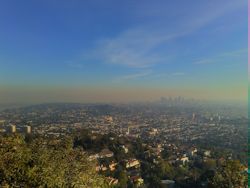SEJournal Online is the digital news magazine of the Society of Environmental Journalists. Learn more about SEJournal Online, including submission, subscription and advertising information.
TipSheet: EPA Inaction Leaves Smog an Endless Summer Story
As summer’s hot, soggy weather engulfs much of the United States, smog will again be a story in many places. If you are reporting on the environment, it may be wise to prepare.
Smog is bad news. But the good news for environmental reporters is that there are a number of ways to get a handle on the story. It is newsier for the fact that officials are fighting over how, or even whether, to tell it.
Smog is that hazy stinging goop — whose worst ingredient is ozone — that forms when nitrogen oxides from combustion and volatile organic compounds from vehicles and other sources are cooked in humid conditions by sunlight. Other pollution makes it worse.
It is found most often in congested urban areas like Los Angeles and Houston, especially when there are no winds to blow it out of the airshed. There is also plenty of it in the megalopolis that is the East Coast.
For many people the stinging eyes and coughing that smog brings are an annoyance. But for people with breathing difficulties, old people and infants, it is a serious health threat. With long enough exposure, everyone’s health can suffer.
Agency drags feet on nonattainment list
The Clean Air Act of 1970 requires the U.S. Environmental Protection Agency and the states to control smog. EPA sets standards based on human health needs, and the states must implement various pollution-control measures in an effort to “attain” those standards.
But if areas — typically metropolitan regions — in a state fail to attain the standards, EPA designates them as “nonattainment areas.” Then negative consequences result, the worst being that EPA will stop allowing permits for new pollution sources, which many areas or businesses see as an economic hardship.
 |
| A view of smog on the Los Angeles Skyline from Griffith Observatory in January, 2008. Photo: Al Pavangkanan, Flickr Creative Commons |
Most areas wish not to be in nonattainment, so quite a bit of politics surrounds designation.
Back in June 2017, new EPA Administrator Scott Pruitt roiled the political waters when he announced he would delay implementation of the latest ozone standards for a year. EPA had tightened the standards in October 2015 (during the Obama years).
Many Republican lawmakers cheered Pruitt on. But a group of downwind states and green groups went to court opposing the delay, and won.
Since then, Pruitt has slow-walked final release of information on which areas are in nonattainment. EPA published a list of areas that were indeed in attainment, but has had trouble naming the others. More lawsuits ensued. Even after a court (again) ordered EPA to stop dragging its feet, EPA still delayed (subscription required).
Finally, in early June, an appeals court set a July 31 deadline (subscription required) for EPA to finish its homework.
Getting started on smog coverage
As an environmental reporter, you don’t have to wait for the nonattainment lists. The smog is likely to start before then.
Do your eyes sting? Is your throat scratchy? When you look at the horizon do you see a yellow-brown haze? A TipSheet last year outlined some of the tools for keeping an eye on smog in your area.
First, check out the initial published list of areas that are in attainment. Then look at the list of additional areas that EPA published in April 2018.
Most importantly, take a readout on how the air is in your area right now. The website called AirNow, run by EPA in collaboration with other agencies, will give you near-real-time air quality data in map form (with forecasts).
The actual monitoring data is collected by state and local air quality management agencies. It would probably be informative to find and contact yours. These data are often reported by local and regional weather outlets.
Keep in mind that one day’s pollution will not put your area in nonattainment. The standards are written as sustained pollution above certain levels over defined lengths of time. It’s the chronic ozone pollution that spells nonattainment.
Our previous TipSheet offered the following additional pointers:
- Previous nonattainment. The previous set of standards for ozone was set back in 2008. If your area had trouble meeting those standards, it’s likely at risk for not meeting the new standards. A map of the old nonattainment areas is here and a list of the areas (e.g., counties, metro areas or tribal areas) is here.
- Last summer’s readings. One nifty thing about EPA’s AirNow site is that it has archives — so you can go back and look at how bad things were during, say, July of last year when the smog was bad. You can get another view of historical information in the county-by-county statistics in EPA’s annual Air Quality Trends.
- Updates from state & local agencies. Every state has an air pollution control agency and you can often get information on where the problems are from them. A list is here. Very often a polluted metropolitan area cuts across jurisdictional boundaries, and many regional or metropolitan air pollution agencies have been formed. Find the one in your area and see what pollution information it offers. Most are on this EPA list.
* From the weekly news magazine SEJournal Online, Vol. 3, No. 25. Content from each new issue of SEJournal Online is available to the public via the SEJournal Online main page. Subscribe to the e-newsletter here. And see past issues of the SEJournal archived here.













 Advertisement
Advertisement 



